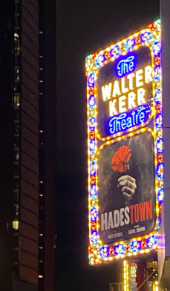Mythology and magic on Broadway

February 10, 2023
From January 26-28, PA’s Chorus and Orchestra had the opportunity to visit New York City. From the glittering city lights, the towering skyscrapers, and the stunning architecture of the Radio City Music Hall to the delicious boba tea in Chinatown and the jaw-droppingly overpriced stores, what stuck with me the most were the two Broadway musicals we saw: Hadestown and Aladdin.
Both musicals took opposite approaches to audience engagement: while Aladdin focused on fast-paced spectacle with gorgeously elaborate sets and special effects (complete with a real “flying” carpet), Hadestown drew me in with its masterfully-crafted soundtrack and its deceptive austerity.
The stage of the Walter Kerr Theatre is small, sparse, and circular, with raised sides to accommodate the orchestra and a turntable in the center to maximize the available space. As a result, every movement feels intentional, and the eye is drawn to what’s important–a welcome relief from Aladdin’s constant movement, which seems to encourage a goldfish-level attention span.
drawn to what’s important–a welcome relief from Aladdin’s constant movement, which seems to encourage a goldfish-level attention span.
While I expected it to have less depth than Hadestown (Disney has to be kid-friendly, after all–although whether children’s media should be “dumbed down” in the first place is its own debate), Aladdin’s story did feel rushed even compared to the original movie. The characters dash from one show-stopping number to the next with little room to develop believable relationships, and the plot doesn’t have much to offer that hasn’t been hashed out a thousand times already–then again, that makes it perfect for when you just want a mildly cheesy, feel-good story with a guaranteed happily ever after.
On the other hand, it isn’t a spoiler to say Hadestown has a tragic ending; the very first song makes that clear. However, this review will go into plot details, so click away if you’re planning to see this show yourself (which I highly recommend)!
Hadestown is a modern retelling of two love stories from Greek mythology: Hades and Persephone as well as Orpheus and Eurydice. Orpheus, the “son of a muse” and a hopelessly romantic musician, falls in love with Eurydice, a “hungry young girl” followed by the Fates. However, their budding love is tested when their world is thrown off balance by the dysfunction between Hades, the King of the Underworld, and Persephone, the goddess of spring.
While aficionados of the original myth will know that Persephone is supposed to split her time between the mortal realm and the underworld (causing the change of seasons), in Hadestown their unhappy marriage has caused spring and fall to disappear altogether.
While Orpheus believes he can repair their world with a magic song he’s writing, he fails to see that Eurydice’s physical needs aren’t being met. Hades eventually persuades her to take the train to the “underworld” of Hadestown: a mine where the workers never go hungry in exchange for what is essentially eternal slave labor.
When Orpheus realizes where Eurydice has gone, he follows her to Hadestown and eventually persuades Hades to let them go with his now-complete song, but only on the condition that Orpheus cannot look back to ensure that Eurydice is following him. Of course, as the first song has reminded us, this is a tragedy, so inevitably Orpheus looks back at the last moment and Eurydice is trapped in the underworld forever–yet I still found myself in suspense, hoping that somehow things would turn out differently.
 Personally, although I could relate to how Orpheus’s self-doubt and insecurity led to self-sabotage–how can you trust others when you don’t trust yourself?–there’s no excuse for the fact that his naivete about the ways of the world and his lack of trust in Eurydice ultimately sentenced her to eternal “death” in Hadestown. However, the narrative is crafted in a way where every character could share part of the blame for the tragedy that occurs, perhaps symbolizing the flaws in both idealism and pragmatism when taken to extremes.
Personally, although I could relate to how Orpheus’s self-doubt and insecurity led to self-sabotage–how can you trust others when you don’t trust yourself?–there’s no excuse for the fact that his naivete about the ways of the world and his lack of trust in Eurydice ultimately sentenced her to eternal “death” in Hadestown. However, the narrative is crafted in a way where every character could share part of the blame for the tragedy that occurs, perhaps symbolizing the flaws in both idealism and pragmatism when taken to extremes.
There were countless subtle parallels to the real world: The inhumane working conditions and economic inequality of Hadestown were uncomfortably reminiscent of sweatshops, for example. Climate change is suggested by the disappearance of spring and fall, as the rift between Hades and Persephone symbolizes the imbalance in nature created by industrialization.
Although Orpheus fails to save Eurydice, his song reminds Hades and Persephone of their love; they commit to repairing their relationship and repairing the mortal realm along with it. Hadestown speaks to the power of music as a reminder that concerns about our world’s future should not cause us to lose hope but rather move us to take action.




